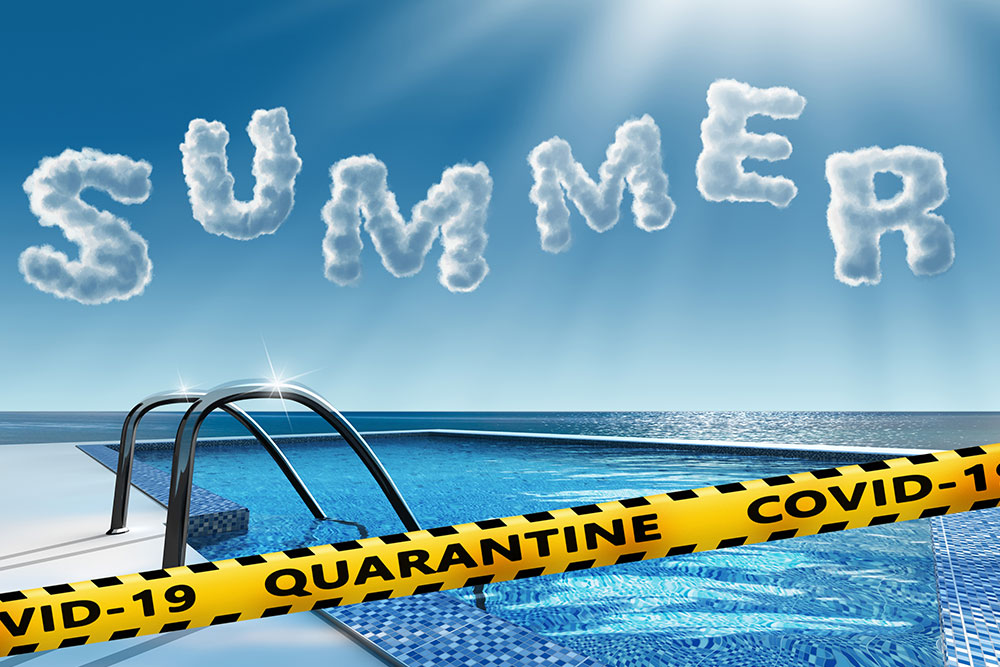
Opening the Flood Gates
REQUIREMENTS FOR SWIMMING POOL OPENINGS IN NEW JERSEY
EXECUTIVE ORDER 153 and DEPARTMENT OF HEALTH STANDARDS
On June 9, Governor Murphy announced that public swimming pools, including community association pools, may open on June 22, 2020, provided compliance with all requirements to be set forth by the standards of the New Jersey Department of Health (DOH). The DOH standards that became available on June 10 are extensive. We have reviewed the DOH standards and summarize them below. Any association considering the possible opening of a swimming pool must thoroughly review these standards, and consider the significant risks inherent in noncompliance, while likely being without insurance coverage for any claim related to COVID-19. For ease of understanding, Becker has reviewed and outlined the DOH requirements below, but this summary does not include the entirety of the rules, which can be found by clicking here.
Summary of DOH COVID-19 Swimming Pool Standards
- Review of CDC Guidelines. While the DOH does not mandate compliance with all CDC guidance on operating and managing pools, it encourages “review of the CDC guidance to assist with making decisions prior to opening.” The CDC guidelines can be found by clicking here.
- COVID-19 Operation Prevention Plan. The association must incorporate in its Aquatics Facility Plan (AFP), required by existing DOH requirements, a COVID-19 Pool Operation Prevention Plan (CPOPP). If the association’s pool management company typically submits the AFP to the local health authority, it will likely undertake this task but an association considering opening should confirm this.
- Requirements for CPOPP. The following is required to be included in the COVID-19 Pool Operation Prevention Plan:
- The CPOPP must provide for “adequately” trained staff to undertake the following:
- Train and equip Pool Directors and Lifeguards.
- Implement an “ambassador role to monitor and encourage social distancing of bathers on the pool deck.”
- Have a COVID-19 contact person.
- The CPOPP must provide for “adequately” trained staff to undertake the following:
- Establish a protocol for PPE acquisition and distribution to staff.
- Document COVID-19 awareness training and risk reduction strategies for all personnel.
- Develop a police notification policy for reporting non-compliance with any activities required by Executive Order No. 153.
- Screen staff by taking temperature readings (not admitting any staff with a temperature of 100.4 or above) and screen for all signs of COVID-19 illness at entry points before admission.
- Designate entry points to pool facility and limit and stagger entry and exit points to avoid congregation.
- Post signage at entrance point and within pool facility to alert for signs of illness and require that any ill person stay home.
- Reduce capacity of pool and surrounding facility to 50% of maximum capacity. Guidance for the capacity of the pool is set forth as 28 square feet of pool surface area per bather. For a 2,000 square foot pool, this equates to not more than 71 bathers.
- A sign-in sheet must be utilized for all staff and patrons to facilitate potential contact tracing efforts.
- It is suggested, but not mandated, that capacity requirements be implemented through a reservation (pass) system, limiting hours of operation, and demarcating grids on pool deck.
- Infection Control Strategies. All pool facilities must implement the following prevention and mitigation strategies to slow and limit COVID-19 exposure and spread:
- Designate a COVID-19 Emergency Care Room. This requires further clarification. At first blush it appears this requirement may be limited to pools having a surface area of 7,000 square feet or more.
- Have procedures for isolating and transporting anyone showing signs and symptoms of COVID-19 as set forth by the CDC.
- Implement enhanced cleaning and disinfection procedures “that includes frequent cleaning and disinfecting of high traffic areas (i.e. rest rooms) and major touch points. This must include sanitizer stations through the pool facility; frequent sanitization of areas opened to the public including cleaning of frequently touched areas several times a day and shared objects after each use. This includes the requirement that railings and ladders be sanitized after each use.
- Prohibit sharing of furniture and equipment. The only effective manner in which to do this will likely be removal of all pool deck furniture.
- If water play equipment is permitted (fins, kickboards, pool noodles, etc.) prohibit sharing except among immediate family members.
- Restrooms. The following policies must be implemented for all restrooms (and shower areas or locker rooms, if they remain open):
- Require foot coverings.
- Limit occupancy to avoid over-crowding and to maintain social distancing. While signage is required, it is recommended that designated personnel oversee the activity in these areas.
- Face Masks Gloves and Social Distancing. Implement measures to ensure social distancing is maintained including:
- Face coverings and/or masks should be worn outside the pool when social distancing of six feet cannot be maintained, unless doing so would be detrimental to an individual’s health.
- Six feet social distancing while in water (except immediate family members or romantic partners.
- “Encourage” six feet of social distancing on pool deck except for usual exceptions.
- Control crowd flow using visible marking, postings or signage.
- Demarcate and post signs that denote six feet of spacing in all commonly used areas or where a line may form.
- Communication Plan. All associations operating a pool facility “must develop and implement an outreach plan” that includes, at a minimum:
- Methods to ensure a continuous public outreach campaign including highly visible signage, websites, and mobile applications to communicate restrictions, set expectations, and emphasize the importance of social distancing and hygiene.
- Signage must be posted stating that (i) face coverings are strongly encouraged; (ii) face coverings should not be worn in the water; (iii) hands should be washed frequently; (iv) hand sanitizer should be used if soap and water are not available; (v) do not touch your face; (vi) stay home if sick; and (vii) practice social distancing.
Becker believes the foregoing requirements are so extensive so as to make compliance difficult and expensive. Furthermore, it is not sufficient to simply implement a plan for compliance, but to also ensure that the plan is being followed. Pool season is typically limited to approximately ten weeks for most associations and over the course of a season, pool use is reported to be in the neighborhood of 15% to 20% of all residents of the community. Given this, subjecting the association, board members, and managers to the risk of a COVID-19 claim because one or more of these extensive requirements is not met may not be prudent. When coupled with the fact that most association general liability insurance policies contain exclusions for communicable diseases and directors and officers’ insurance policies have never covered claims for personal injury, it highlights the inherent risks in opening pools. Should a claim be filed the association is unlikely to be provided a defense, which, alone, may be very expensive. And while it is believed that COVID-19 claims will be difficult to prove, should a judgment be awarded, the association would be required to assess their owners. Furthermore, the governing board members would have to rely on indemnification from the association for any claim made against them personally. For these reasons, our recommendation is for boards to carefully evaluate the risks and benefits to the association when determining whether to open swimming pools for the 2020 summer season.
In no event should a board undertake to open a pool without first consulting with counsel. Whether a governing board desires to open the association’s swimming pool or keep it closed, your Becker attorney is available to assist in preparing policies that meet your needs and protect the association’s interests. Of course, we are available for any questions and to assist in any manner we can. Please contact us if you have any questions concerning the foregoing.
FAQS
Q: Can’t our association and board simply post signs stating, “Swim at Your Own Risk” and avoid all of the Department of Health’s requirements?
A: No. As a “public pool” under state law and the DOH’s regulations the operator of a pool that is open to the membership must comply with all DOH requirements. These requirements cannot be avoided. By posting “Swim at Your Own Risk” signs, the association signals that the pool is open for use, hence requiring it to meet all of the requirements and be responsible even if it is not.
Q: If we have all people who wish to use the pool sign waivers, doesn’t that absolve the association and board members of liability?
A: While it is our opinion that if an association opens its pool, it is good practice to obtain a waiver from each person using it, the association should not rely on it. There are a number of reasons for this. First, waivers are generally disfavored by the law because they encourage lack of care. Second, if the State’s policy is to require pool operators to keep the pool in a safe and healthy condition for bathers, courts will not enforce waivers that suggest the pool operator is not liable for an unsafe condition, such as failing to strictly follow the DOH’s COVID-19 rules. Further, no effective waiver can be obtained for minors and if any person who did not use the pool became infected by a COVID-19 positive person who did use the pool, no waiver would absolve the association from liability to that third party.
Q: Our pool management company is familiar with all of these DOH requirements and if we have it undertake these responsibilities, won’t we be free of liability?
A: First, we are advised that although most pool management companies will provide lifeguards and undertake the testing and treatment of the water if an association chooses to open during the coronavirus pandemic, it will not agree to be responsible for the sanitation, social distance monitoring, demarcating distancing requirements on the pool deck, etc. It is likely that the liability coverage maintained by pool companies are subject to the same exclusions as the association’s policy, making them liable for uninsured risks. Second, in the unlikely case where a pool company undertakes these responsibilities, the common practice of plaintiffs’ lawyers is to name all possible parties, which would include the association. While the association might, in that instance, be able to pass the liability to the pool company it would still be required to participate in the lawsuit at considerable expense.
Q: If we do not open the pool, don’t we have to refund some of the maintenance fees to the owners since we aren’t providing that service?
A: While the association may realize some reduction in expenses related to not opening the pool, there are other pool-related expenses that it will still be undertaking to maintain the pool in good operating condition. As in any year, the budget is a projection, not a guarantee of the expenses the association will undertake. We are less than half-way through the calendar year as of the writing of this article. The association does not know what unexpected expenses it may have, including the possibility that due to the economic impact caused by the pandemic, there may be an increase in delinquencies over the remainder of the year that could offset any savings. Fellow owners can be told that if any surplus is realized by the end of the fiscal year, that surplus will be used to offset required income to meet next year’s budget expenses, thereby providing the “refund” they are seeking.
Q: How do we deal with the anger that will be expressed by owners if we choose not to open?
A: While it is undoubtedly true that some owners will be unhappy and some even angry if the board opts to not open the pool, the owners likely do not know all of the background the board was required to consider in making a decision. While some owners will remain dissatisfied, those who are clear-eyed and fair minded will understand this was not a decision made lightly. If requested, we can assist the board in a communication to the owner explaining the factors that led to the board’s decision. It will be important to maintain communications with your owners during this time to avoid the perception that the board is simply acting in a knee-jerk reaction to the pandemic.




